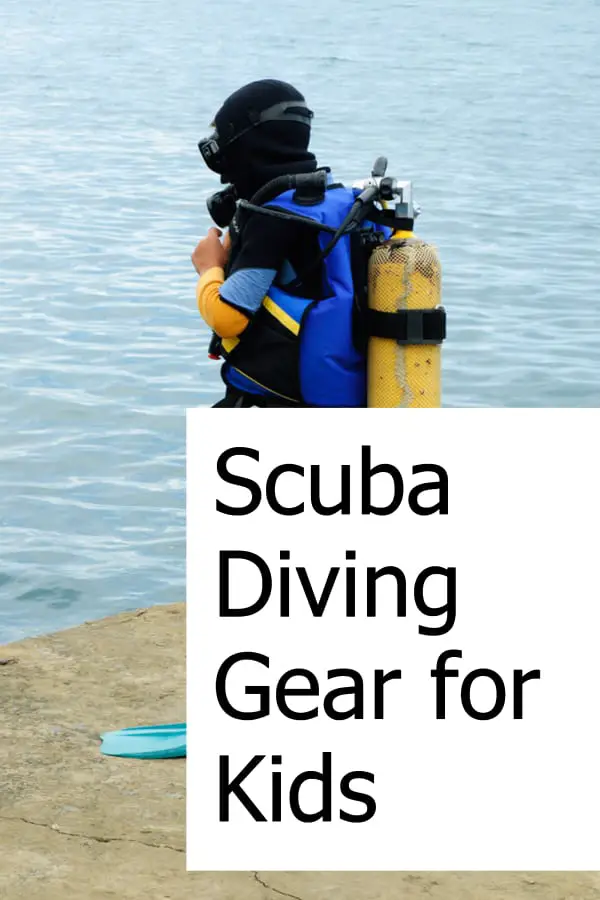Best Scuba Diving Gear for Kids for Underwater Fun for the Family
Scuba diving is an excellent sport for kids – once they have the correct training and equipment. There is so much to explore for kids beneath the surface of the water. For kids, it is a fascinating new frontier.
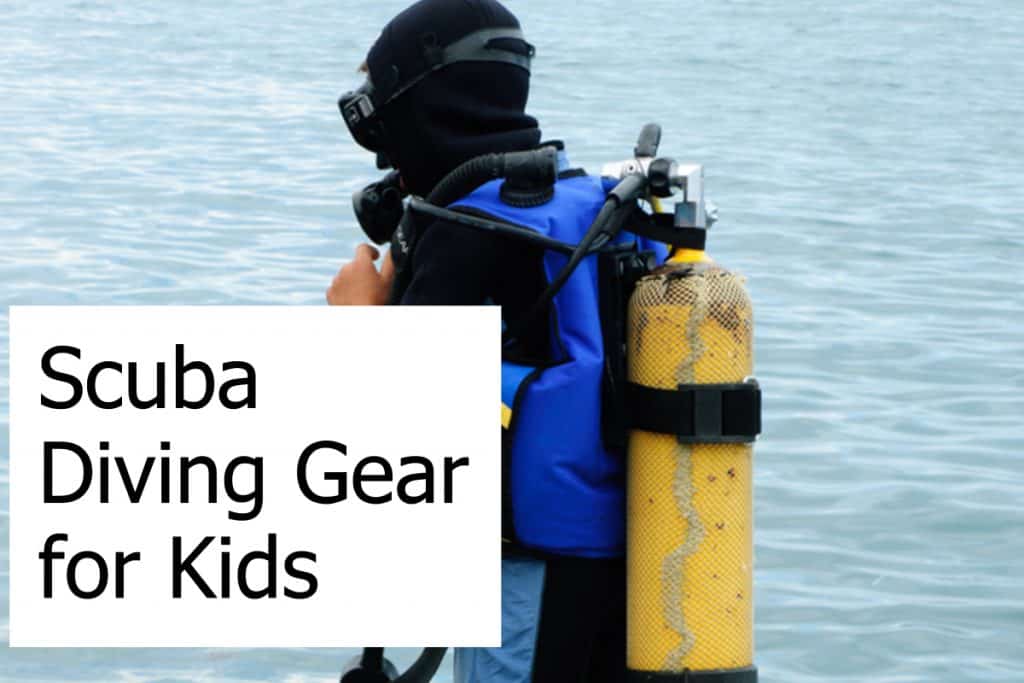
Not only will scuba diving introduce a child to a great deal of science, but it’s also good fun. When kids have the opportunity to go scuba diving, they put down the video games, turn off the TV, and dive into a mysterious world of exotic plants and animals. Furthermore, physical activity will help the bodies of kids to grow strong and their minds become disciplined.
Unfortunately, the amount of equipment for your children that is needed is the same as for adults. You’ll need to look at different scuba gear. Let’s have a look at what specific scuba gear for kids you’ll need to consider.
Diving Masks
Masks are often the first piece of scuba gear that a child is introduced to. With just a well-fitting mask, a kid can explore the aquatic world close to the shore.
The mask must fit comfortably and snuggly on the child’s face or water will seep in around the edges, causing him or her to feel uncertain about how scuba gear can help them remain safe and have fun diving. A good mask will also work well for snorkeling when your kiddo doesn’t want to dive.
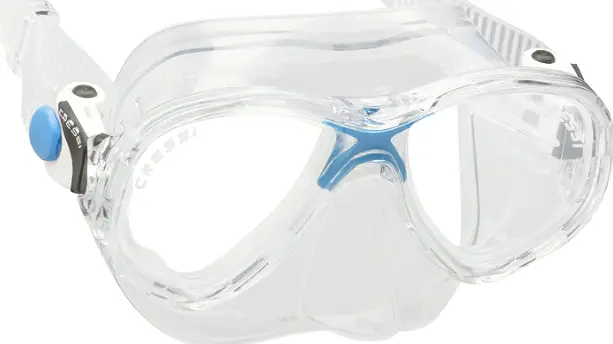
Mask Material
Masks are made of rubber, silicone, and neoprene. It is important to try on several masks to allow the kids to learn that each one will fit and feel different. Help your child find a mask that fits perfectly and feels soft and snug on his face.
To find a good-fitting diving mask for kids, have the child place the scuba mask over her eyes and nose without putting the head strap behind the head. Brush her hair back so that it doesn’t interfere with the seal between his face and mask.
Instruct the child to breathe in through her nose and hold her breath for a few seconds. If the mask fits her face well, it should stay in place for a few seconds without being held with her hand. If the seal is not good, there will be no suction when she breaths in, so try a different diving mask.
Masks are THE essential scuba gear for kids or adults. Make sure to get a scuba mask that fits your kid’s size. A pair of scuba goggles that fits correctly will make a huge difference in the experience your child has when diving.
Strap Adjustments for fitting a mask perfectly
The strap that holds the diving mask on the child’s head should be adjustable and comfortable. A popular style is the wide split strap because it conforms to the back of the head and feels more secure.
Finding the Best Full Face Scuba Mask
Advantages and Disadvantages of a Full-Face Scuba Diving Mask
Dry vs. Semi Dry vs. Wet Snorkel – What are the Differences?
Snorkels for Scuba Diving
The traditional, stick-like snorkel is often the second piece of scuba equipment the child learns to use. This simple snorkel attaches to the strap of the mask, allowing the child to snorkel along the surface of the water with his eyes facing downward while breathing through the snorkel.
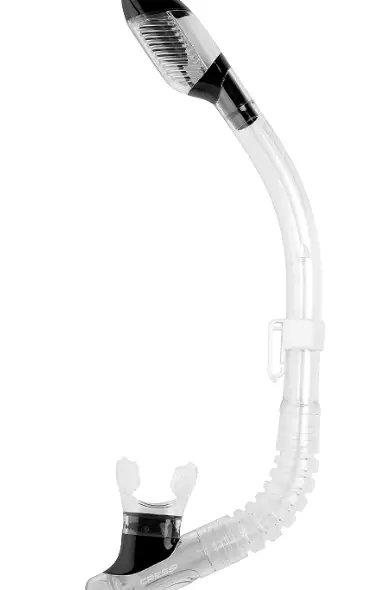
Head underwater with the snorkel
With practice, she will learn to swim for a few seconds under the water with her mask and snorkel. Kids will do this by placing the tongue into the snorkel’s mouthpiece and going under the surface with the snorkel.
Even if the entire snorkel is in and under the water surface, she is keeping the water from entering her mouth. When she surfaces, she blows the water out of her snorkel and continues to swim along the surface while watching the world below her.
You might think that using a dry snorkel would be the best idea? That is true for snorkeling. However, many divers prefer a wet or semi-dry snorkel as this gear is easier to handle when diving. A dry-top snorkel will potentially hold air in the snorkel tube which can become irritating when the kid is diving due to its buoyancy impact. That doesn’t matter for snorkeling but it does when you dive.
When the child masters this technique and handling of scuba equipment and can swim underwater and surface repeatedly with ease, his confidence and poise in the water will have grown tremendously.
Being able to handle snorkel gear correctly is essential. Using a snorkel while above water reduces the air used from the tank while not diving. Your kids should be comfortable with the snorkel so they have more time and safety margin when diving.
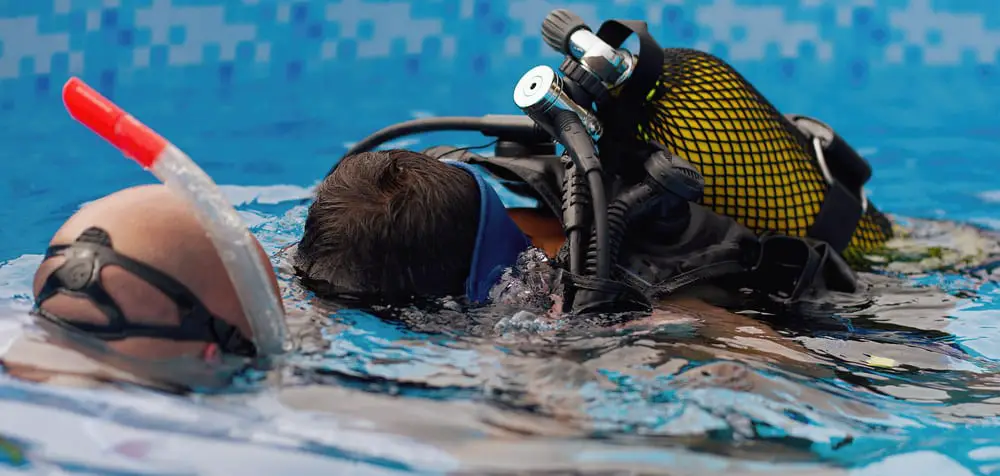
Fins for Kids
Fins can be introduced once the kid is proficient with the mask and snorkel. The child will feel powerful as she zooms through the water while wearing fins.
At the outset, care must be taken that the child does not stray too far from adults since the fins allow her to travel further distances in a shorter period of time.
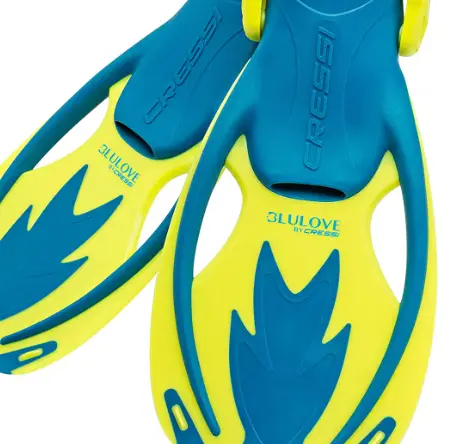
Split Fins vs Regular Fins and Blade Flippers for Scuba Diving
In order to enjoy the sport of scuba diving, kids need scuba equipment that fits them well and feels comfortable. You wouldn’t put a size 12 shoe on a 10-year-old boy. Just as on land, gear should fit well and cause no damage to the tender skin on the child’s feet.
Diving fins for kids not only help the child propel faster through the water, but they also help to build strong leg muscles.
There are two basic types of fins to choose from:
* Full foot fins
* Open heel fins
Full-Foot Fins for Children
Full foot fins are the most popular choice of gear when it comes to fins for kids. These diving fins feel more snug and secure on the feet. When walking on the shore or on the bottom of the ocean or lake, the heel is not exposed because the entire bottom of the child’s foot is covered by the scuba fin.
Open-Heel Fins for Children – Booties Required
The open-back fin often comes with an adjustable heel strap. This is convenient and economical for the fast-growing feet of kids.
However, the heel is exposed with this gear when walking with these diving fins, so if there may be sharp objects that can cut the heel, this might not be the right choice of gear. Open-heel fins are usually used with booties. This additional scuba gear for kids will reduce the risk of chafing on the heel and feet of kids as well as let the kids walk safely on land when you’re shore diving.
Also, take care that the strap is comfortable and snug on the back of the heel and around the boot if your kids use them.
BC’s or BCD’s
BC stands for buoyancy compensator. BCD stands for “buoyancy control device”.
This piece of scuba diving equipment helps the person maintain the proper level of buoyancy. It’s a life-saving device that helps you ascend, descend, and float on the surface, similar to a life jacket.
Your kids can certainly snorkel without a snorkel vest but safely diving without a BC is not really the best idea. In our opinion, a BCD is an essential piece of gear for kids when you go scuba as a family. More important to have that gear though is that the kids can control it!
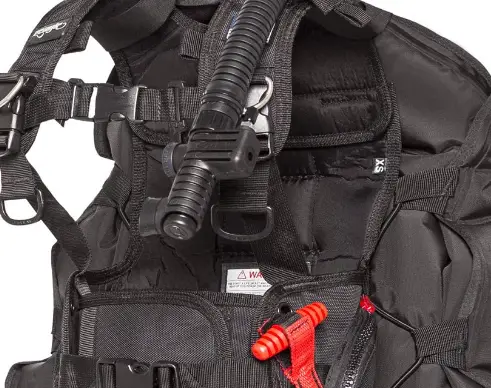
If the diver wants to stay on the surface of the water or float up from the seafloor, he wants more buoyancy. If he wants to descend into the water, he wants less buoyancy.
When maintaining a certain depth, the buoyancy is neutral. Mastering a BCD is essential to control ascent and descent speed and the need to stay at a specific depth when scuba diving. Make sure that this gear for kids fits perfectly and that your kid masters the usage of the BCD.
Best Travel BCD’s For Your Next Trip – Reviews and Buying Guide
BCD Bladder Filling – Buoyancy Diving Equipment for Kids
The level of buoyancy is controlled by the amount of air in the BCD’s inflatable bladder. The bladder can be filled in two ways:
- From the air tank through the regulator
- From the diver’s mouth through an inflation valve (a backup safety feature)
Regulate the Buoyancy
When the diver wants less buoyancy, air can be released from the bladder using a vent valve. There are usually two vent valves – one on the top to the BCD and one on the bottom of that piece of gear. Additionally, there is an over-pressure relief valve that automatically operates when the bladder is overfilled or when the diver is ascending.
BCDs also have a place to fit the air cylinder as well as pockets for weights. It is designed with clips to keep air hoses in place and prevent tangling.
Match the BCD to the Kid’s Size
A child must wear a BCD designed for a person of the kids’ height and weight. Shoulder, sternum, and waist straps need to fit well and cross the body in the proper place. There should be easy-to-operate squeeze-type buckles so that the child can get her own BCD on and off.
Jacket-Style – Most popular BCD type for kids
Jacket-style BCD’s are the most popular type for kids. The BCD should be durable and easy to operate. For safety, it should have clear markings on the shoulders for adults and diving buddies to see easily.
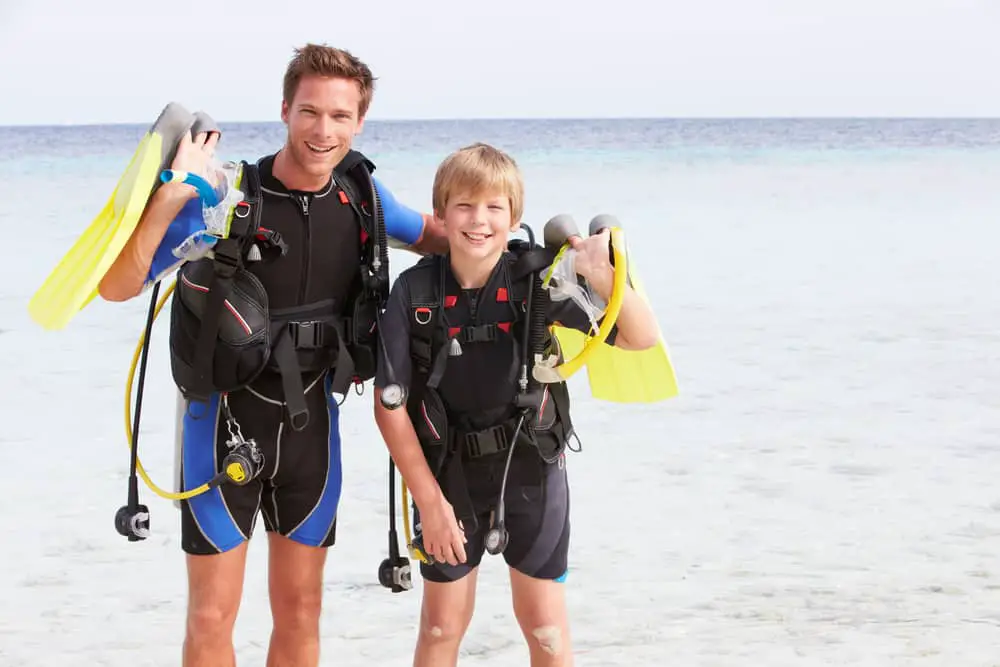
Wet Suits
Wetsuits hold a small film of water between the suit and your child’s skin. His body warms the water, which then acts as an insulation layer. This keeps him from being overly affected by cold water or harsh changes in temperature.
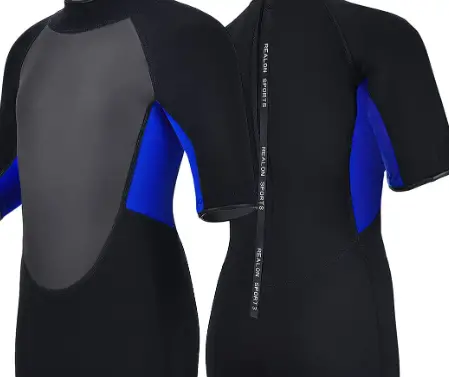
Wetsuit Thickness Guide – Is Thick Neoprene Keeping You Warm?
Wetsuits are designed to be flexible so that the child can move comfortably both in the water and onshore. Short sleeve wetsuits increase the child’s arm mobility.
Get the right wetsuit for children
Although originally invented for cold water diving (Differences between Diving In Cold vs. Warm Water), there are now wetsuits designed for warmer water. Sometimes called a shorty, this style has short sleeves and short pants. It goes over the child’s regular swimsuit and acts as a protective barrier for the child’s skin where the BCD is secured to his torso.
In cold water, the warm water shorty can be used over any full one-piece wetsuit to give an extra layer of thermal protection.
The Thickness of the Neoprene counts
Wetsuits are made of a wide variety of materials, such as nylon neoprene or lycra skin. They also come in various thicknesses.
Before choosing a wetsuit for your child, investigate the benefits of each wetsuit, and be sure the wetsuit is designed for the diving environment your child will be experiencing. Wetsuits are the few components of scuba gear for kids that your child will grow out of regularly. Keep that in mind and check out whether you can buy and sell used wetsuits for kids to make this part of the scuba equipment more affordable.
Regulator – Junior Size
Your child’s mouth is smaller than an adult one. Therefore, having a regulator with a mouthpiece that fits a kid’s mouth is important.
Keep Lung Capacity of kids in mind
Younger kids also do not have the lung capacity or strength to breathe heavy when they are in the water and the surrounding pressure builds up. The regulator has to make sure that the breathing is easy for the kid.
Last but not least, the regulator is a piece of dive gear that allows your child to breathe when diving. A malfunctioning regulator can lead to devastating outcomes. You won’t need the highest-end reg but a solid regulator as part of your scuba gear for kids is advisable.
Quality, not price, is key for Scuba Diving Equipment for Kids
Make sure to pay attention to get a good quality regulator that is designed to work with children’s anatomy! A good regulator that’s specifically designed for children is the ScubaPro MK2 EVO/R095 Dive Regulator System.
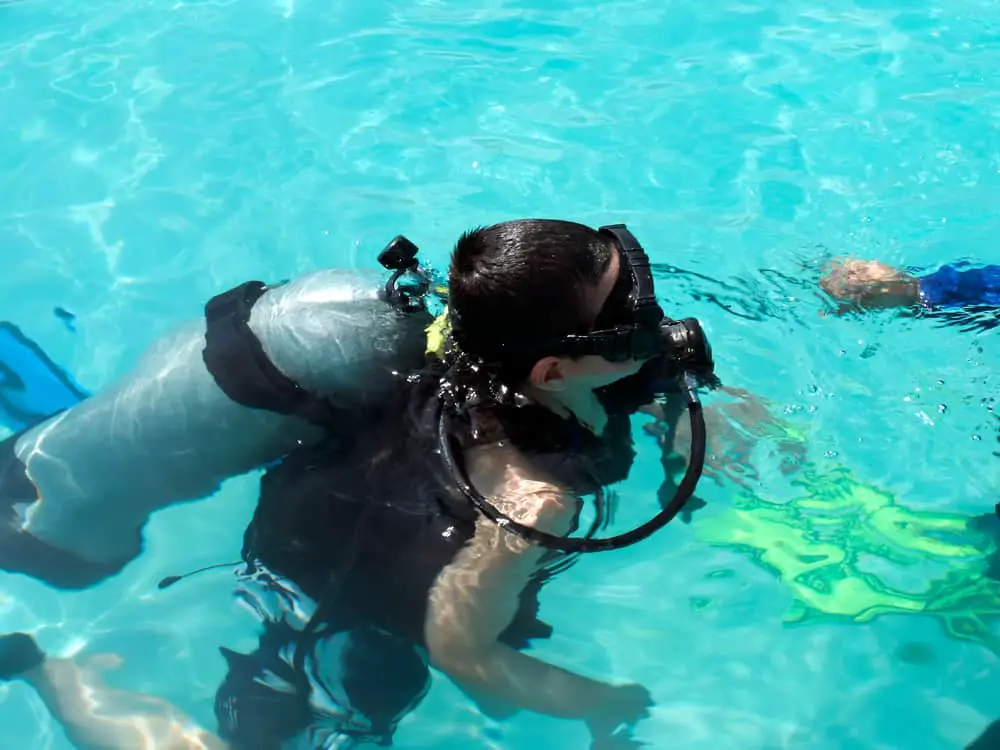
Final Thoughts
Scuba diving (as well as snorkeling) can be an exciting and challenging sport for your kids. There is a lot to learn to dive safely. With so many experienced divers enjoying this sport, you can always find an instructor who will teach your child the best way to go.
Make it fun for the kids!
To increase the child’s enjoyment and chances for success in this sport, you need to choose the best equipment and scuba gear for kids you can afford. Always see that the mask, fins, wetsuit, and BCD, as well as other scuba gear, fit correctly as the kids grow. When needed, upgrade to a larger size or a better model. If scuba equipment is well cared for, then the kids’ scuba gear can be sold or passed down to a smaller person.
There is a whole world of wonder to be explored beneath the surface of the ocean, lake, or pond. Consider opening this world to your children and watch the kids’ knowledge and enthusiasm for healthy fun to grow deep. Keep your kids safe by providing them with the appropriate scuba gear for kids.
Pin It – Dive Gear for Kids (Masks, Fins, Wetsuits)
If you liked the scuba gear for kids overview and want to pin it to Pinterest or share it with your friends on Facebook, Twitter, or other social media then we kindly would ask that you use the image below to do so. We appreciate your support!
